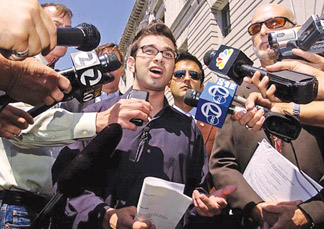|
Writers’ source a key resource:
Admirable attributes of attribution
Gaston De ROSAYRO
|

Always source your information
|
If someone has given you information that you are using in your news
or feature story you will need to identify your source and explain why
that person is worth listening to. This is attribution.
A journalism professor may have an interesting opinion on the finance
minister’s economic policy, but his opinion would be worthless in a news
story unless he is also qualified to speak as an economist. Columnists
and commentators can use themselves as the authority for the correctness
of the news, but such a privilege does not extend to the ordinary news
writer.
Readers would want to know where the story came from and why they
should believe it. When possible always identify the source fully. Give
the person’s full name and also his or her title. Also some affiliation
to show the reader that the person is worth quoting.
The next best attribution is the name of the source’s organisation,
group or office. Any time the information in your story comes from a
source and not from your own firsthand observations it should be
attributed. A good rule of thumb is to attribute once per paragraph. It
may seem repetitive, but it is important for reporters to be clear about
where their information originates.
The least satisfactory attribution is some variation of the phrase
“informed sources.” This form of attribution is necessary if the origin
of the news must be held in confidence. In some cases, your sources of
information may not want to be named, for fear of reprisals.
Journalists who are sure of their facts often attribute such
information to “usually reliable sources”, “informed sources” or
“sources within the government, department or company”.In some cases,
they use phrases such as “it is widely believed that” or “it is
understood that”. Be warned! If your information is wrong, the blame
will rest at your door.
In cases where fact and opinion are not easily separated, play safe
and attribute the story.And remember that attributing a statement to
someone else is no defence in a claim for defamation. If you wrongly
accuse a person of being a thief, it is no excuse to say that you were
just quoting someone else.
The insistence on sources sometimes causes inexperienced writers to
clutter their leads. Titles or names of news sources, locations or news
conferences and other necessary and not consequential details need not
always be crammed into leads.
|

Readers would want to know where the story came from and why
they should believe it |
The good journalist has to strike a balance between the need to make
clear attribution of statements and the risk of boring the reader with
too many phrases such as “he said”.It helps to change the word “said”
occasionally, in attributing both quotes and reported speech.
Some useful alternatives are “warned”, “suggested”, “urged”, “asked”
and “disclosed”. But again beware: because each of these has a specific
meaning. Check that it is the correct one for what your speaker said and
the way they said it.
The phrase “according to” can be used in attributing reported speech,
but do not use it more than once with any single speaker.
Although it is usually a neutral term, not suggesting either belief
or disbelief, if you use it too often it can give the impression that
you doubt the information the speaker has given.There are other, more
obvious danger words to avoid such as “stated” and “pointed out.” They
both imply that what the speaker said is an undisputed fact. You can,
for example, point out that the world is round, but you cannot point out
that this cake is delicious, because that is an opinion.
Also avoid the word “claimed”, which suggests that you do not believe
what is being said. Be especially careful when reporting court cases.
Lawyers and the police like to use the word “claimed” to throw doubt
on opposition statements. You must not do the same.The exact balance of
attribution depends on the kind of story you are writing or the material
you can use.
If the statements are reliably factual throughout, you only need to
attribute occasionally. If, however, the story is heavy with opinion or
unreliable statements, you should attribute at least once every two
sentences.
One of the greatest dangers facing the young journalist is accepting
what people say as the truth. Just because someone tells you that
something is a fact, does not make it so.There are some things which are
universally accepted as true, for example that the world is round, that
Tuesday follows Monday, that Sri Lanka is an island in the Indian Ocean.
But there are also things which people want you to believe are true
but which are either not provable or are lies. These people may not
knowingly tell a lie, but many people are careless with the truth.Also,
situations may change, so that the truth at one moment may be wrong the
next. Attribution helps you to overcome some of these problems.
Attribution is the act of specifying who said what.
If you attribute the words to the person who said them, you do not
have to prove or disprove the veracity of their words. You simply report
them. Also, people judge what is said by the person who says it.
Statements made by people in authority carry more weight than statements
made by other people.
Names in your story must also be accurate. There can be no compromise
on this. Never, ever get a person’s name wrong. Close enough is not
accurate enough. Even if a man tells you his name is Perera don’t assume
you know how to spell it. Ask him if it can be spelt Perera, Pereira or
Ferreira. Even Western and Sri Lankan common names can have different
spellings. Safer still ask for a calling card.
There are a multitude of factors that tend to condition the
acceptance of sources as bona fide by investigative journalists.
Reporters are expected to develop and cultivate sources, especially if
they regularly cover a specific topic, known as a “beat”.
Beat reporters must, however, be cautious of becoming too close to
their sources. Reporters often, but not always, give greater leeway to
sources with little experience.
For example, sometimes a person will say they don’t want to talk, and
then proceed to talk. If that person is not a public figure, reporters
are less likely to use that information. As a general rule, but
especially when reporting on controversy, reporters are expected to use
multiple sources.
And however good you think your memory is always recheck and look up
things you quote. Also never, repeat, never assume anything. Journalists
are also encouraged to be sceptical without being cynical. If your
mother says she loves you, check it out. |



